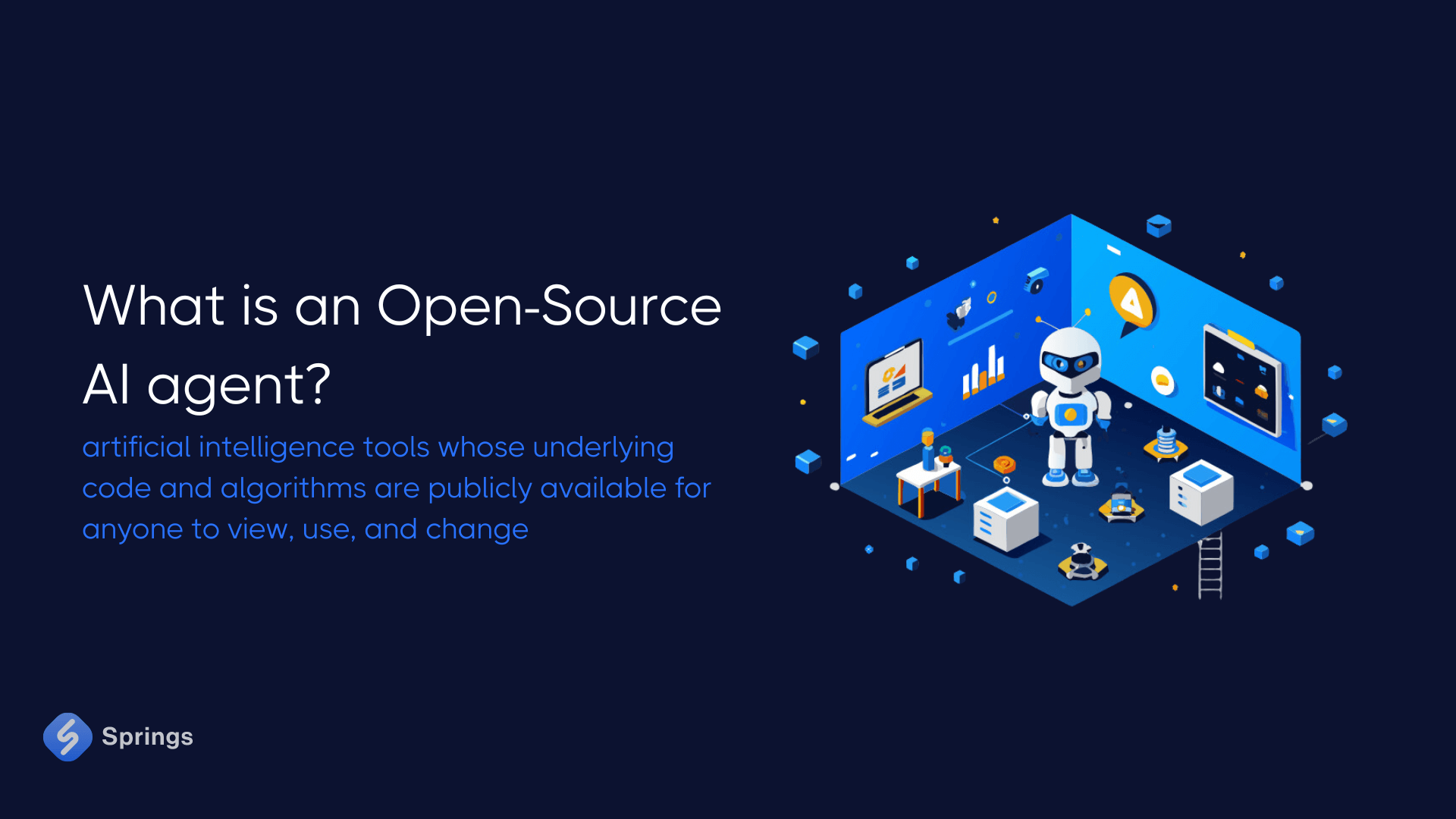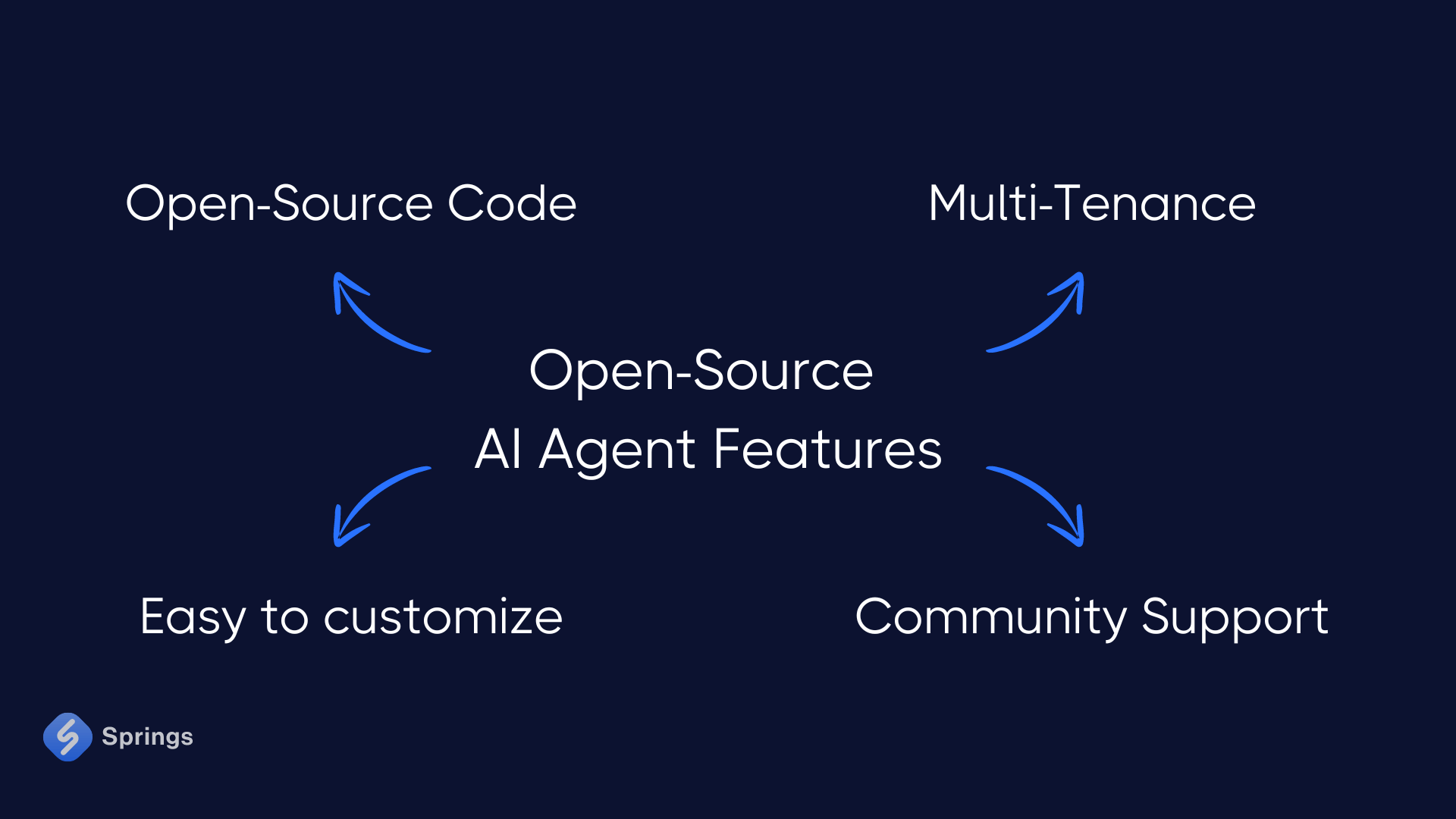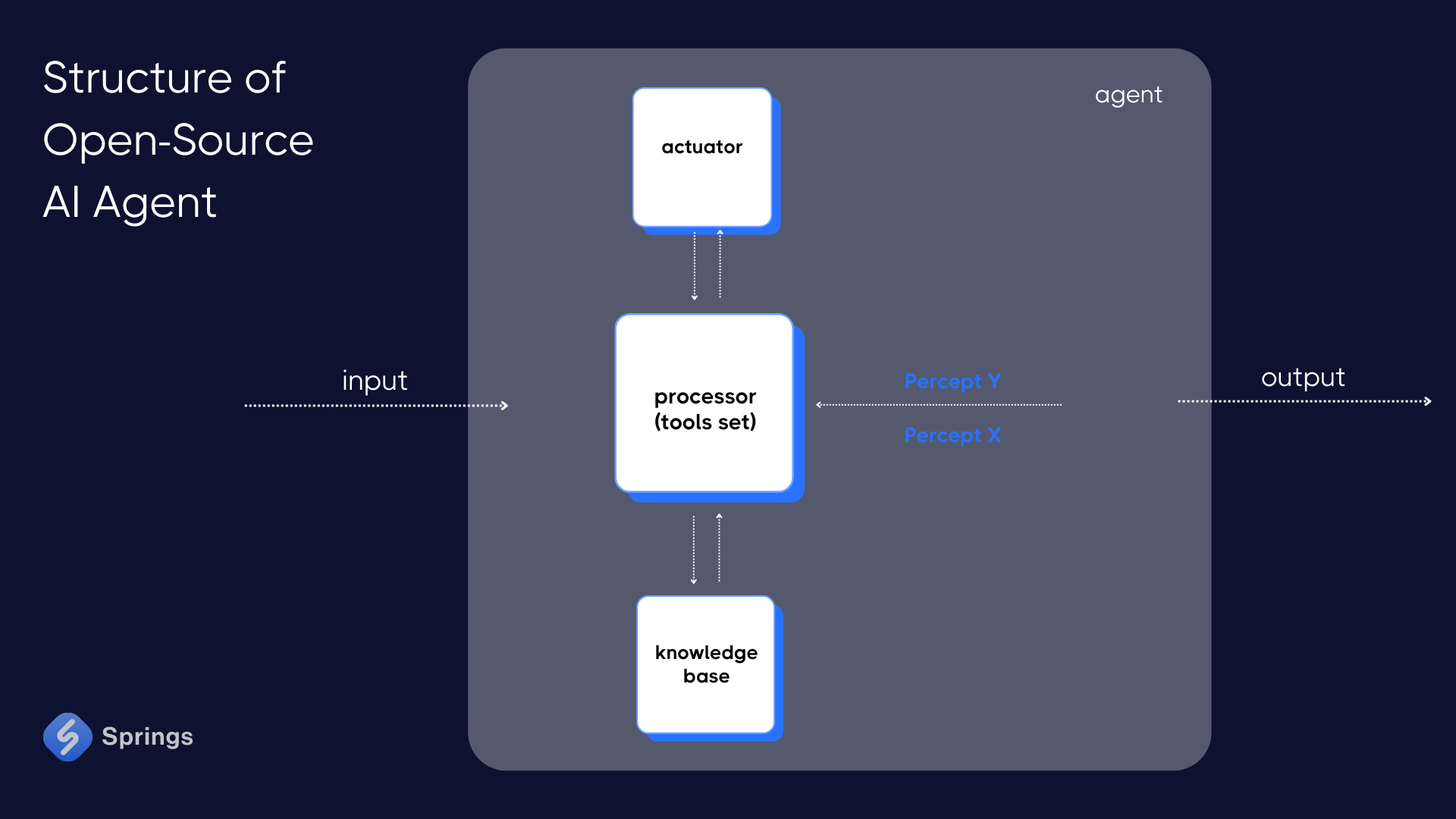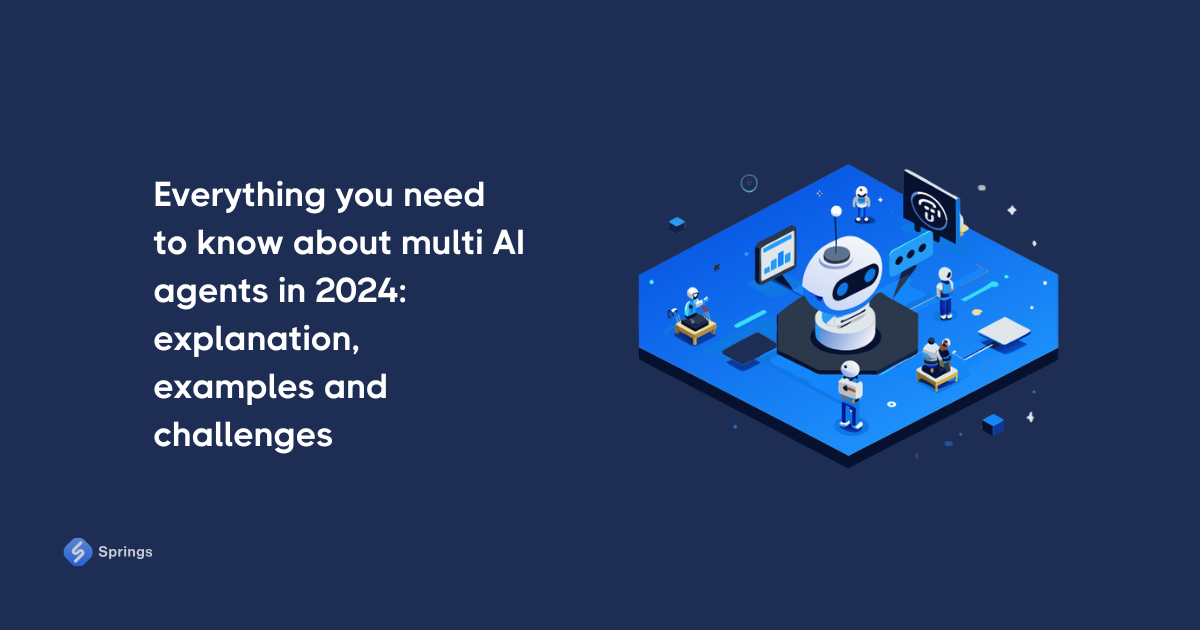Open-Source AI Agents: How to Use Them and Best Examples
Intro
The battle between open-source and closed-source technologies has been ongoing for a long time. In our previous articles, we did deep research on open-source and closed-source LLMs - let’s try to find out more about open source AI agents that really often use large language models.
Irene Soleiman from Wired did interesting research on open-closed-source AI tools. It is stated in her research that many people think of this as a binary question: systems can either be open source or closed source. Open development decentralizes power so that many people can collectively work on AI systems to make sure they reflect their needs and values, as seen with BigScience’s BLOOM.
While openness allows more people to contribute to AI research and development, the potential for harm and misuse, especially from malicious actors, increases with more access. Closed-source systems, like Google’s original LaMDA release, are protected from actors outside the developer organization but cannot be audited or evaluated by external researchers.
So, let’s try to understand: whether AI agents open source or closed source type of AI. Or both?
What is an open-source AI agent?
AI agents like any other tools can be built with a different technical approach allowing them to be used in a certain environment in multiple ways. In case an AI agent is developed and deployed on a source that can be used by any user on the internet - it will be open-sourced.

In other words, open source AI agents are artificial intelligence tools whose underlying code and algorithms are publicly available for anyone to view, use, and change. This openness allows developers, researchers, and business owners to collaborate, improve, and customize the AI agent to fit specific needs or explore new capabilities.
Open Source AI Agent Features
To better understand the specifics of open-source AI agents, let us try to determine their key features.

- Open Source Code. The source code of any open-source AI agent is fully accessible, allowing coders to understand how the AI agent works, what data it uses, and how it performs tasks.
- Multi-Tenance. Multiple “tenants” (contributors) can work together to enhance the AI agent's functionality, fix bugs, or add new features. This collaborative environment often leads to rapid advancements and further growth.
- Easy to customize. AI Agents’ users can modify them to suit their business requirements, whether it's for research, predictive analysis, or other practical applications. This flexibility could be really valuable for enterprises with unique needs.
- Community Support. Another AI agent's open source feature is that they can benefit from a community of users and developers who provide support, share knowledge, and contribute to the agent's ongoing development.
Structure of Open-Source AI Agent
Almost every open source AI agent typically consists of the following components:

- Core ML Model. This is the central AI logic that processes inputs and generates outputs. It can use, for instance, open-source large language models like LLaMa or Falcon.
- Knowledge Base (KB). Usually, it includes the data that the agent can learn from or use to make decisions.
- Interaction Layer. Comprises NLP modules for understanding and generating human language, and APIs for connecting with other systems.
- Learning Algorithms. AI agents may use reinforcement learning or continual learning to improve over time based on user interactions and feedback.
- Pre-Deployed. Open-source agents are often containerized (e.g., Docker) and designed for easy deployment on cloud platforms.
How to Use Open-Source AI Agents?
Before implementing any new technology in a business, almost any business owner or manager would be interested in understanding how it had been implemented before. Obviously, this is a good point to start with especially when we talk about AI agents open source basics.

So, there are multiple ways to use open source AI agents. Let’s have a look at some popular examples.
Big Data AI Search
One of the use cases we often met is the development of a GPT Researcher-based agent that is designed to navigate and compile vast amounts of public data into structured databases. Using open-source models, this kind of agent can autonomously search, filter, and summarize information from diverse online sources, making it invaluable for researchers, analysts, and organizations. The flexibility of open-source frameworks ensures that the GPT Researcher can be tailored to specific fields, enhancing both the accuracy and relevance of the data it compiles.
For example, it can be used for searching leads according to the set ICP in the areas of education, logistics, retail, ecommerce, and many others.
AI Avatar Streaming
Another popular application is the open-source AI Avatar for live streaming. This AI agent interacts with viewers in real time, generating dynamic responses and engaging conversations during live streams. By integrating natural language processing and lipsync technologies, the AI Avatar creates a lifelike and interactive experience, enriching the viewer's experience.
Open-source tools allow for continuous refinement, enabling developers to add new features, expressions, or specialized knowledge, keeping the avatar relevant and engaging across different platforms and audiences.
A real example of using AI Avatars may be found in one of our projects: Text-to-Video AI Builder. This is a multilanguage text-to-video platform allowing you to build customized AI videos with a presenter using only text and your voice if you would like to.
AI Employees
The modern concept of an AI Employee Agent is significantly gaining traction, where AI agents based on open-source models from platforms like Hugging Face can automate routine tasks in business environments. Moreover, these agents can handle customer inquiries, process data, manage scheduling, and assist in complex decision-making processes.
The open-source core of such solutions allows businesses and enterprises to customize the AI Employee to fit their specific needs, integrating seamlessly with pre-existing workflows and providing a scalable, cost-effective solution for increasing productivity and KPIs. This approach not only reduces costs and saves time but also helps businesses to grow continuously with the support of a global tech AI community together with the new AI trends.
Multiagent System
The potential of open-source AI extends further with different Multi-Agent Systems that could be based on the best open-source large language models (LLMs). These AI solutions involve multiple AI agents working collaboratively to solve complex problems, such as coordinating tasks in large-scale simulations or managing decentralized decision-making processes.
Moreover, open-source LLMs allow these agents to communicate effectively and share knowledge, leading to more sophisticated and efficient outcomes. This combined AI framework can be applied in industries like logistics, finance, and education, where this kind of intelligence can significantly enhance performance using Conversational AI or other approaches.
List of 10 Best Open-Source Agents
Now, let’s have a look at the real samples of open source AI agents and the platforms that provide their customization.
IONI
IONI is an AI Agents platform developed and supported by Springs company. IONI allows you to create and fully customize open-source AI agents to your specific business needs. Also, with provided open source AI agents, you can seamlessly integrate existing AI tools or develop custom solutions to ensure your agents are optimized for your unique challenges and objectives.
Moreover, this platform supports the development of multi-agent systems, where multiple AI agents collaborate to solve complex problems. By using open-source models combined with multiple third-party services (APIs) like Stripe or Hubspot, we ensure that your AI agents communicate effectively and work together to achieve sophisticated outcomes.
We offer a free trial where you can explore standard functionalities, such as AI Chatbot and AI Avatar, and determine for yourself what customizations or new tools may be necessary. Our team is here to support you from initial POC discussions to the deployment of a full-scoped solution that evolves with your company.
If you need any help or you would like to start your project right away - don’t hesitate to contact us and we will guide you through the whole process.
Crew AI
Crew AI is a modern tool for managing autonomous AI agents. It uses collaborative intelligence, enabling agents to work together seamlessly and tackle complex tasks. Crew AI can customize agents with specific roles, goals, and tools. Agents can autonomously delegate tasks and inquire amongst themselves, enhancing problem-solving efficiency.
This tool also has flexible Task Management - it can define tasks with customizable tools and assign them to agents dynamically. Finally, the product supports sequential task execution and hierarchical processes.
Crew AI is designed with production in mind, offering the flexibility of conversational agents and structured processes, without rigidity. It allows agents to assume roles, share goals, and operate cohesively, making it suitable for building smart assistant platforms, automated customer service ensembles, or multi-agent research teams.
Auto-GPT
Auto-GPT is an AI agent that operates using Python programming language and uses a GPT large language model. Auto-GPT works similarly to ChatGPT, with the added feature of AI agents. AI agents can be programmed to make decisions and take actions based on a set of rules and predefined goals.
The technologies of Auto-GPT provide the possibility to perform specific tasks on your behalf, such as scheduling appointments or sending emails. AI agents operate on the principle of limited access. Just as a personal assistant can only perform tasks that are within its scope of access, an AI agent is only as powerful as the access it is given through an API.
Being in the list of open source AI agents, Auto-GPT is pretty similar to ChatGPT. They both are built on the same technology, but they differ significantly in their functionality. The primary difference between the two is that Auto-GPT can function autonomously without the need for human agents, whereas ChatGPT requires human prompts to operate.
Phidata
Phidata AI is a framework for building AI Assistants with memory, knowledge, and tools. We may use Phidata to turn any LLM into an AI Assistant (aka Agent) that can search the web using DuckDuckGo, Google, etc., and pull data from APIs like yfinance, polygon, etc.
Also, they can analyze data, conduct research, and generate reports. Phidata agents are capable of answering questions from PDFs, and APIs, as well as summarizing articles, videos, etc. Finally, they may perform tasks like sending emails, and querying databases.
Overall, Phidata streamlines the development of reliable AI products by efficiently managing memory, knowledge, and tools. It offers a robust framework for creating autonomous assistants capable of engaging in structured conversations and executing complex tasks. With support for multiple LLMs, databases, and vector stores, Phidata provides seamless integration with existing systems. The platform also includes essential features like monitoring, evaluations, human review, and a prompt registry, enabling AI engineers to build and maintain high-quality AI applications with ease.
Autogen
AutoGen is an open-source framework that uses multiple agents to enable complex workflows. While there are many definitions of AI agents, in AutoGen, an agent is an entity that can send messages, receive messages, and generate a reply using models, tools, human inputs, or a mixture of them. This abstraction not only allows AI agents to model real-world and abstract entities, such as people and algorithms, but it also simplifies the implementation of complex workflows as collaboration among agents.
Moreover, AutoGen is extensible and composable: you can extend a simple agent with customizable components and create workflows that can combine these agents and power a more sophisticated agent, resulting in implementations that are modular and easy to maintain.
Most importantly, AutoGen is developed by a vibrant community of researchers and engineers.
It uses the latest research in multi-agent systems and has been used in many real-world applications, including agent platforms, advertising, AI employees, blog writing, blockchain, calculating burned areas by wildfires, customer support, and many other industries.
Cal AI
Cal AI is an open-source AI agent created to speed up the process of managing appointments and meetings. By the usage of advanced natural language processing and machine learning techniques, this agent can autonomously handle scheduling tasks, reducing the need for manual input and coordination. Users can interact with the agent through various platforms, allowing for seamless integration into their existing workflows.
One of the main features of Cal AI is its ability to integrate with a wide range of calendars and communication tools, making it a versatile solution for individuals and organizations alike. Whether it’s syncing with Google Calendar, Microsoft Outlook, or other scheduling platforms, the agent can manage multiple calendars and time zones effortlessly.
Finally, being open-source, this agent offers a high degree of flexibility and transparency. Developers can access the source code, contribute to its improvement, or tailor the agent’s capabilities to suit unique business requirements. This fosters a collaborative environment where the AI agent can evolve with the needs of its users. Additionally, the platform provides robust documentation and a supportive community, making it easier for users to get started and for developers to innovate on top of the existing framework.
MetaGPT
MetaGPT is a framework designed for programming in multi-agent collaborative environments, specifically using the Large Language Models. Its main contribution is the integration of human workflows into LLM-based multi-agent collaboration, which is effective for complex software engineering tasks. The framework assigns different roles to the GPT model, similar to a pipeline in software development, including roles such as product manager, architect, and engineer.
MetaGPT can solve complex tasks by using different AI agents to handle different parts of the problem. It also provides sensible solutions that favor tasks that require different elements to work together seamlessly. Another great advantage of MetaGPT is its possibility to be used for different tasks, and provide multiple outputs ranging from project plans to technical documentation.
If we talk about the weaknesses of this product, a key issue with MetaGPT is the lack of innovation in its methodology. While it effectively uses the top-notch LLMs in multi-agent systems, this approach may not differ significantly from existing approaches. MetaGPT is different from other methods in a trivial way. Moreover, the comparison methods used to assess the effectiveness of MetaGPT do not appear to be fully equivalent to what MetaGPT offers. Such differences may lead to biased or misleading conclusions about their superiority or efficiency.
ChemCrow
ChemCrow is one of the popular open source AI agents specifically designed to assist in the field of chemistry, providing powerful tools for researchers and scientists. Using the most advanced NLP-based tools and LLMs, ChemCrow can interpret and generate chemical data, automate complex calculations, and even suggest experimental procedures. This makes it an invaluable resource for chemists looking to enhance productivity and precision in their research, whether they are working in academic, pharmaceutical, or industrial settings.
One of the key strengths of ChemCrow lies in its ability to integrate with various chemical databases and computational tools, allowing users to access a vast repository of chemical information and perform intricate analyses with ease. By automating tasks such as data mining, compound identification, and reaction prediction, ChemCrow significantly reduces the manual effort involved in chemical research, freeing up time for more critical, creative aspects of scientific inquiry. Its ability to process and understand scientific literature also makes it a powerful assistant for staying up-to-date with the latest advancements in the field.
Being a completely open-source platform, ChemCrow is highly customizable and adaptable to the specific needs of its users. Scientists and developers can modify the agent’s capabilities, integrate it with specialized software, or contribute to its ongoing development, ensuring that it continues to meet specific demands.
BabyAGI
BabyAGI is an AI-powered task management system that uses OpenAI and Pinecone APIs to create, prioritize, and execute tasks.
Moreover, the system uses vector databases such as Chroma or Weaviate to create, prioritize, and execute tasks. The main idea behind this system is that it creates tasks based on the result of previous tasks and a predefined objective. The script then uses OpenAI’s NLP capabilities to create new tasks based on the objective, and Chroma/Weaviate to store and retrieve task results for context.
Additionally, the system evolves by absorbing new information and learning from it, thereby improving and adapting to new tasks and challenges over time. Its configuration is designed to tackle complex issues intelligently. With tasks and goals steering its learning process, BabyAGI remains focused and efficient. Memory is crucial, aiding in the retrieval and application of knowledge.
AgentGPT
AgentGPT is a modern platform that allows users to build autonomous AI agents capable of performing complex tasks without requiring extensive coding knowledge. This platform uses the latest large language models to create agents that can independently execute various operations, from automating workflows to conducting detailed research.
One of the core features of AgentGPT is its user-friendly interface, which simplifies the process of setting up and managing AI agents. Users can define the objectives and parameters for their agents through an intuitive dashboard, allowing for quick deployment and real-time monitoring of their tasks. The platform supports integration with various tools and APIs, enabling the AI agents to interact seamlessly with different systems and environments. This level of flexibility makes AgentGPT a great solution for businesses and individuals looking to automate complex processes.
Overall, AgentGPT’s open-source capacities also allow users to customize their AI agents to fit unique requirements, whether for business automation, content creation, or data analysis.
Conclusion
As far as we can see, open-source AI agents have become popular tools in terms of business automation and AI development. There are multiple options you may find on the market, customized to your requirements, and already pre-deployed.
The rise of open-source AI agents is speeding up the growth of artificial intelligence, providing accessible, customizable, and scalable solutions across many industries. AI Agent platforms, like AutoGPT, IONI, or Autogen, help businesses build and set up AI agents to their specific needs, increasing the possibilities of business development.
As far as more companies and enterprises contribute to benefiting from open-source AI, we can expect continued growth and innovation, making AI more integrated into everyday business operations.





